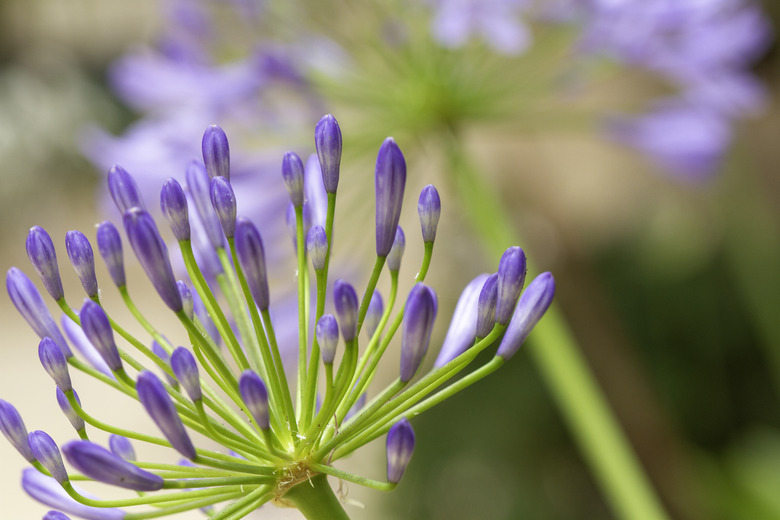What Causes Yellow Leaves On An Agapanthus?
We may receive a commission on purchases made from links.
Commonly known as the lily-of-the-Nile, agapanthus (Agapanthus spp.) is a perennial plant that does best when grown in U.S. Department of Agriculture plant hardiness zones 9 through 11. While the plant's low-growing, strap-like leaves are attractive, the tall purple flowers are what draw the eye. Agapanthus is an easy grower but, like all plants, it is susceptible to environmental problems, and a few pests that can turn the foliage yellow.
Iron Chlorosis Yellowing
Iron Chlorosis Yellowing
The most common symptom of iron chlorosis, or a lack of iron, particularly in young growth, is yellow leaves with green veins. A prevalent misconception about this condition is that the soil is deficient in iron, but this may not be the case. There are many reasons the agapanthus cannot use the iron present in the soil. Spraying the leaves with iron is a temporary solution, but determining the cause is key to curing the problem.
Use a soil testing kit to determine the soil's pH. If the soil is alkaline with a pH of more than 7, it needs to be lowered to at least 6.5 for the agapanthus' roots to effectively use the iron present in the soil. Sulfur, spread on the surface of the soil around the agapanthus, is the best best way to lower the soil's pH. Follow the instructions included in your testing kit to determine how much sulfur to provide based on the soil's current pH.
As a general rule, you can achieve a 1-point reduction in soil pH by applying 12 pounds of organic soil acidifier containing sulfur per 100 square feet. Scatter the material evenly around the plant and spread it to the drip line with a rake. Water the agapanthus as you normally do after the application. Check the soil's pH again in 60 days and repeat the application, if necessary.
Agapanthus Watering Considerations
Agapanthus Watering Considerations
If the soil's pH is normal, consider how often and how much you water the agapanthus. Overwatering may cause chlorosis. Ensure that your automatic sprinkler or drip system isn't set for summer watering needs in the spring when rains may deliver adequate soil moisture.
Yellowing From Sunburn
Yellowing From Sunburn
Although agapanthus grows and flowers best when it's grown in full sun, if your plant has adapted to fog or overcast conditions, it may suffer from sunburn during periods of intense, hot sun. Those planted with a southern or southwestern exposure and those under stress from a lack of water are particularly susceptible to sunburn. Protect the agapanthus by offering it shade in the afternoon and by spreading a layer of mulch around it. The mulch helps insulate the soil and preserve its moisture content.
Red Spider Mites and Mealybugs
Red Spider Mites and Mealybugs
Tiny spider look-alikes, red spider mites (Tetranychus urticae) and mealybugs (Pseudococcidae) are both attracted to agapanthus. They'll puncture the foliage and suck out the juices, leaving small, yellow spots as evidence of their presence. As the infestation increases, leaves may turn completely yellow and wilt.
Control both pests by spraying the agapanthus with insecticidal soap. Pre-mixed formulas are the most convenient and readily available. Follow the instructions on the product label and thoroughly spray the agapanthus, including the undersides of the leaves. Reapply once a week until the infestation is under control.
Insecticidal soap may be harmful to aquatic life, so ensure that the product doesn't run off into gutters, storm drains or ditches. Apply the product on a windless day when the temperature won't exceed 90 degrees Fahrenheit.
Fungus Gnat Larvae
Fungus Gnat Larvae
As the name suggests, fungus gnats (Bradysia coprophila) thrive in damp soil that contains fungi for their larvae to feed on. These tiny flies lay their eggs in the soil. The larvae hatch within a few days and may feed on the agapanthus' roots or root hairs, causing the plant's leaves to turn yellow.
Control fungus gnats by spraying the agapanthus with ready-to-use insecticide containing permethrin until the product drips from the plant. It's important to spray all parts of the plant, including the undersides of the foliage. Repeat the application every four to eight days if the problem persists. Wash your hands immediately after using the insecticide and don't allow people or pets in the area during the application and afterward, until the product dries. Spray the agapanthus on a windless morning or early evening when the temperature is between 50 and 75 degrees Fahrenheit
Control the insect's larvae by drenching the soil with Steinernema feltiae, beneficial nematodes that will seek out and consume the larvae. Water the agapanthus as you normally do before applying the nematodes to the soil. Keep the nematodes refrigerated before using them and follow the manufacturer's instructions carefully. As a general rule, 5 million nematodes will treat a 1,600 square foot area. Apply the nematodes early in the morning while the weather is cool by adding them to a watering can filled with water and drenching the soil around the agapanthus with the mixture.
